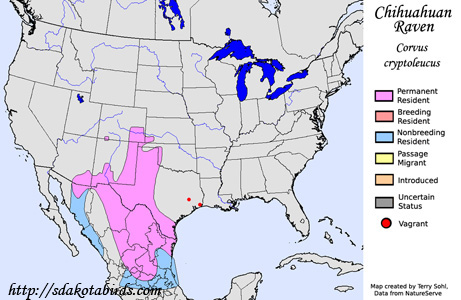| Length: 19 inches | Wingspan: 44 inches | Seasonality: Non-resident in South Dakota |
| ID Keys: Dark plumage overall, thick bill with long bristly feathers on upper mandible, shaggy throat | ||
 The
Chihuahuan Raven is found in the arid grasslands of the southwestern United
States and Mexico, in habitats not often frequented by their larger and more
common relatives, the Common Raven.
While similar in appearance to the Common Raven, they are significantly
smaller, but have a proportionally more stout bill. As with other
Corvid species, they have adapted well to a human presence, and are a common
sight at garbage dumps and other locations where they can feed on human
refuse.
The
Chihuahuan Raven is found in the arid grasslands of the southwestern United
States and Mexico, in habitats not often frequented by their larger and more
common relatives, the Common Raven.
While similar in appearance to the Common Raven, they are significantly
smaller, but have a proportionally more stout bill. As with other
Corvid species, they have adapted well to a human presence, and are a common
sight at garbage dumps and other locations where they can feed on human
refuse.
Habitat: Found in arid grasslands of the southwestern United States and Mexico. They can also be found in low-elevation shrublands.
Diet: Omnivorous, feeding on a large proportion of animal matter, but also feeding on vegetation. Food items include large insects and spiders, bird eggs and young birds, earthworms, small rodents, small lizards, small snakes, grain, seeds, fruit, berries, carrion, and refuse.
Behavior: Foraging techniques depend upon location and available food items. Much of their foraging is done on the ground, but they will also forage in the branches and foliage of trees and shrubs.
Nesting: The nest of a Chihuahuan Raven is a large platform of sticks, lined with softer material such as bark fibers, grasses, and animal hair. The female lays between 4 and 7 eggs, and both parents help to incubate them. When the eggs hatch, both parents help feed the young, who leave the nest after about one month.
Song: Has a relatively high-pitched croaking call that usually rises slightly in pitch toward the end.
Migration: Considered a permanent resident throughout much of its range. However, some birds in the do move southward for the winter.
Interactive eBird Map: Click for access to an interactive eBird map of Chihuahuan Raven sightings
Similar Species: Similar in appearance to the Common Raven, and could also be confused with the American Crow or Tamaulipas Crow in range. The Chihuahuan Raven is intermediate in size between the Common Raven and the American Crow.
Conservation Status: Populations are large, spread over a wide geographic area, and appear to be stable. The IUCN lists the Chihuahuan Raven as a species of "Least Concern".
Further Information: 1) WhatBird - Chihuahuan Raven
2) BirdLife International - Chihuahuan Raven
3) Audubon Guide - Chihuahuan Raven
Photo Information: Photo taken on November 10th, 2015 - Las Cinegas Natural Resource Area, southeast of Tucson, Arizona - Terry Sohl
| Click below for a higher-resolution map |
 |
| South Dakota Status: Non-resident in South Dakota |
Additional Chihuahuan Raven Photos



